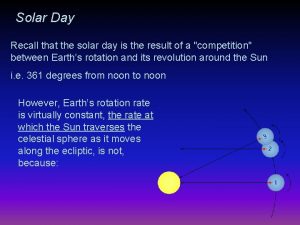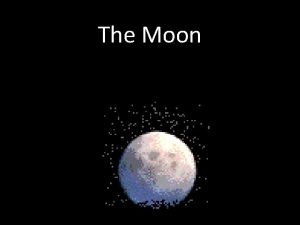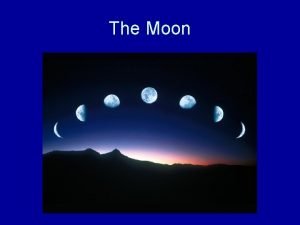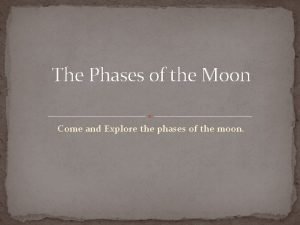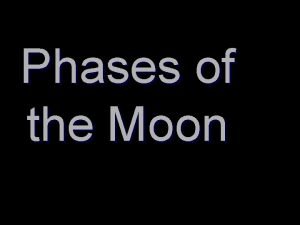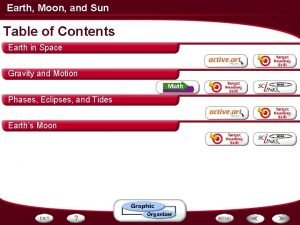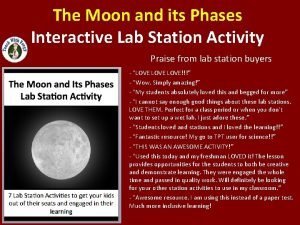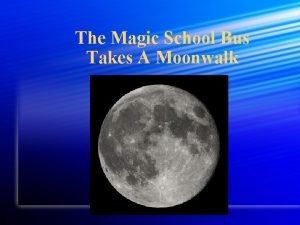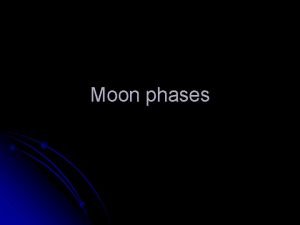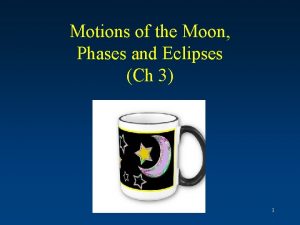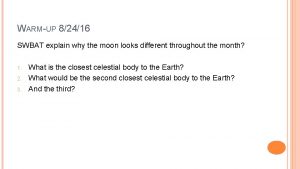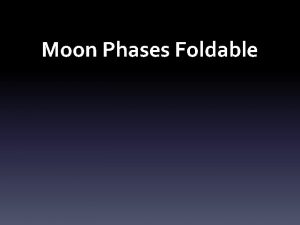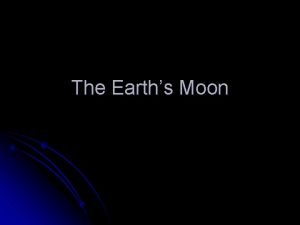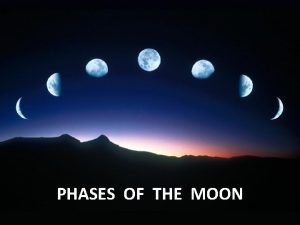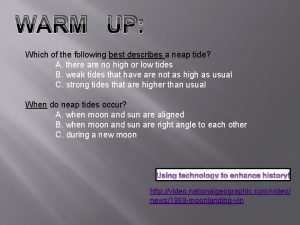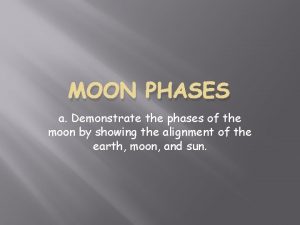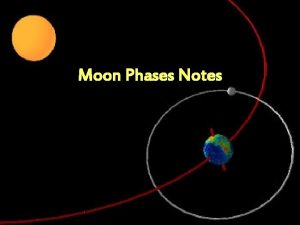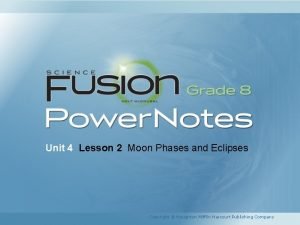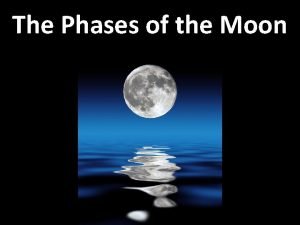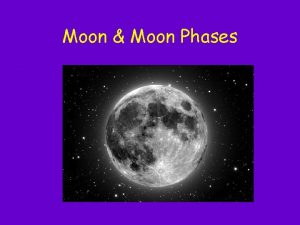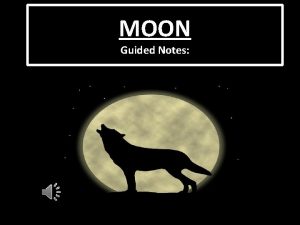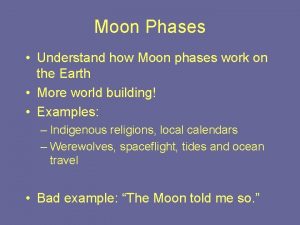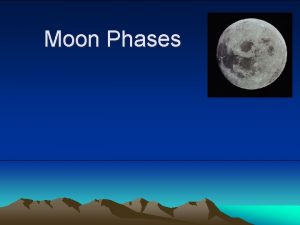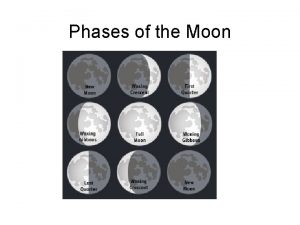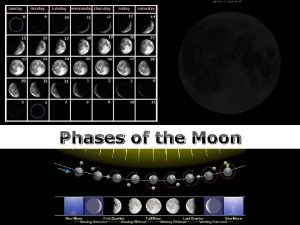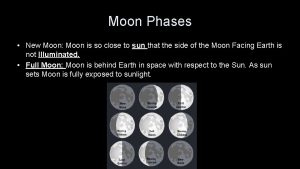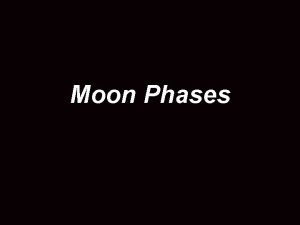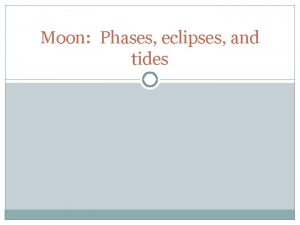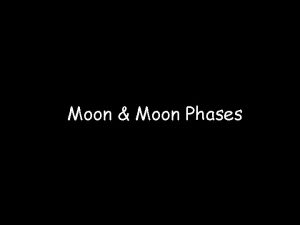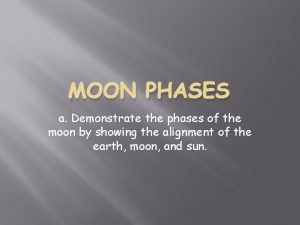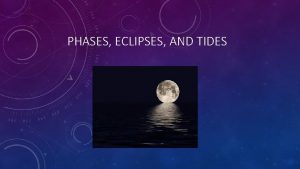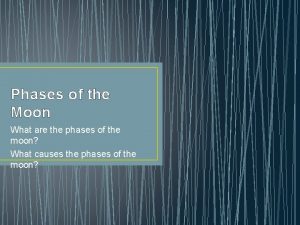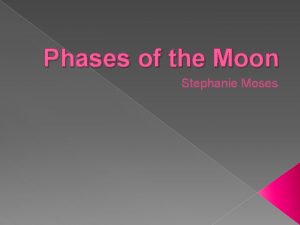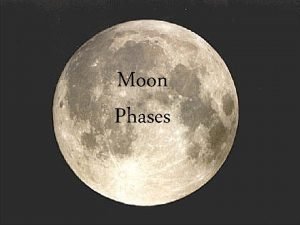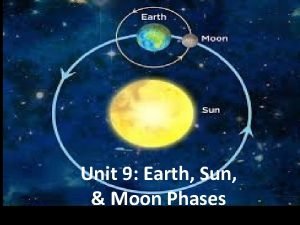Phases of the Moon Phases of the Moon




























- Slides: 28

Phases of the Moon

Phases of the Moon • The first astronomical event to be understood was the regular cycle of the phases of the moon. • On a monthly basis, we observe the phases of the moon as a change in the amount of the moon that appears lit. http: //www. google. com/imgres? sa=X&biw=1093 &bih=496&tbm=isch&tbnid=8 h. O 020 phy. Rz. Et. M% 3 A&imgrefurl=http%3 A%2 F%2 Fblog. boatpeopleb outique. com%2 Fdiy-moon-phasesjacket&docid=Ilg 5 QSWwh. X 61 M&imgurl=http%3 A%2 F%2 Fblog. boatpeopleb outique. com%2 Fwpcontent%2 Fuploads%2 F 2013%2 F 03%2 FPhasesm oon. jpg&w=1600&h=687&ei=y. LPz. Uos 3 q. YTIAamf g. K&zoom=1&ved=0 CGw. Qh. Bww. CA&iact=rc&d ur=292&page=1&start=0&ndsp=9

Phases of the Moon • Look at the new moon shown in the figure. • About two days after the new moon, a thin sliver (crescent phase) appears low in the western sky just after sunset.

Phases of the Moon • During the following week, the lighted portion of the moon visible from Earth increases (waxing) to a half circle (firstquarter phase) and can be seen from about noon to midnight.

Phases of the Moon • In another week, the complete disk (full-moon phase) can be seen rising in the east as the sun is sinking in the west. • During the next two weeks, the percentage of the moon that can be seen steadily declines (waning), until the moon disappears altogether (new-moon phase)

In the box draw and label each moon phase

Phases of the Moon • Lunar phases are a result of the motion of the moon and the sunlight that is reflected from its surface. • To an observer on Earth, the percentage of the bright side that is visible depends on the location of the moon with respect to the sun and Earth.

Phases of the Moon • When the moon lies between the sun and Earth, none of its bright side faces Earth. • This is a new moon. https: //www. google. com/imgres? imgurl&imgrefurl=http%3 A %2 F%2 Fwww. moonconnection. com%2 Fmoon_phases. phtml &h=0&w=0&sz=1&tbnid=OBSu. Whzo 7 Tpmn. M&tbnh=213&tbn w=237&zoom=1&docid=ap. GI 7 Ypo. Fy. NNM&ei=ic. Lz. Uq. Ss. CLHgs. ASfl. IHg. Dg&ved=0 CAIQs. CUo. AA

Phases of the Moon • After the new moon comes the waxing crescent. (a crescent shape can be seen lit on the right side).

Phases of the Moon • After the waxing crescent comes a first quarter moon in which the right half of the moon appears lit.

Phases of the Moon • Following the first quarter is the waxing gibbous • The moon is in gibbous phase when more than half of it is lit.

Phases of the Moon • Following waxing gibbous is the full moon phase in which the entire side of the moon facing Earth appears lit. • From full moon the cycle moves to waning gibbous – The bulge appears on the left.

Click photo for video • From waning gibbous, the moon moves into 3 rd quarter – the left half of the moon appears lit. • From 3 rd quarter the moon moves into waning crescent, and finally back to new moon.

Eclipses • A lunar eclipse occurs when the Earth passes between the Moon and the Sun, and the Earth's shadow obscures the moon or a portion of it. • Only occur during full moon phases when Earth is between the sun and moon http: //www. google. com/imgres? biw=942&bih=4 28&tbm=isch&tbnid=Motb. GDGv. M 6 Jqn. M%3 A&i mgrefurl=http%3 A%2 F%2 Fstarryskies. com%2 FTh e_sky%2 Fevents%2 Flunar 2003%2 Feclipse 1. html&docid=dj 07 b 0 ZLc. E 16 VM &imgurl=http%3 A%2 F%2 Fstarryskies. com%2 FTh e_sky%2 Fevents%2 Flunar 2003%2 Flunar. eclipse 01. jpg&w=571&h=283&ei= bs. IGU-Pd. Dbm 2 AWjj 4 C 4 Dg&zoom=1&ved=0 CLo. BEIQc. MBk& iact=rc&dur=279&page=3&start=14&ndsp=12

Eclipses • A solar eclipse occurs when the Moon passes between the Earth and the Sun, blocking all or a portion of the Sun. http: //www. google. com/imgres? sa=X&biw=942&b ih=428&tbm=isch&tbnid=VFjfm. DRpqtt. XM%3 A&imgrefurl=http%3 A%2 F%2 Fqcw eather. blogspot. com%2 F 2012%2 F 05%2 Fsolareclipse. html&docid=i. Ed. YVg 1 Hj 1 JTBM&imgurl=http %3 A%2 F%2 F 3. bp. blogspot. com%2 Fz 67 z. XPIEu. KM%2 FT 7 h. Uiiv. V 8 q. I%2 FAAAADOY %2 FENRd. RQ 8 Mj. M%2 Fs 1600%2 Feclipse 1. JPG&w=720&h=486&ei= 18 EGU 6 uh. Oa. Wi 2 QX 41 o. Hw. Bg&zoom=1&ved=0 CLo BEIQc. MB 8&iact=rc&dur=458&page=3&start=20&n dsp=12

Umbra and Penumbra • Because the Sun appears as a disk ~1/2° across, Sun shadows are fuzzy rather than sharp. • This means shadows cast by the Earth & Moon are two -part shadows: The Umbra - Inner core of total darkness The disc of the Sun is completely blocked. The Penumbra - Outer, partial shadow Sun's disc is only partly blocked, with a bit peeking over the edge.


Click for Eclipse Video










• http: //www. moonconnection. com/lunar_vs_s olar. phtml • http: //www. astronomy. ohiostate. edu/~pogge/Ast 161/Unit 2/eclipses. html
 Moon phases
Moon phases Define moon phases
Define moon phases Moon phases and eclipses
Moon phases and eclipses What is the moon made out of
What is the moon made out of What causes the phases of the moon
What causes the phases of the moon Seven phases of the moon
Seven phases of the moon How is the moon illuminated
How is the moon illuminated What causes crescent moon
What causes crescent moon Phases of the moon animation
Phases of the moon animation The phases of moon occur mainly due to
The phases of moon occur mainly due to Moon phases interactive notebook
Moon phases interactive notebook Moon phases characteristics
Moon phases characteristics Magic school bus moon phases
Magic school bus moon phases Which earth
Which earth Moon phases
Moon phases What causes the phases of the moon
What causes the phases of the moon Moon phases and eclipses
Moon phases and eclipses Moon phases when the sun is on the left
Moon phases when the sun is on the left Moon phases bingo
Moon phases bingo Moon phases foldable
Moon phases foldable Moon phases
Moon phases Northern hemisphere moon phases
Northern hemisphere moon phases Which statement best describes the phases of the moon?
Which statement best describes the phases of the moon? Moon phases when the sun is on the left
Moon phases when the sun is on the left Eight phases of the moon
Eight phases of the moon Movement on the moon
Movement on the moon Lesson 2 moon phases and eclipses answer key
Lesson 2 moon phases and eclipses answer key During ____ phases more of the moon is visible each night
During ____ phases more of the moon is visible each night Moon phases foldable
Moon phases foldable
